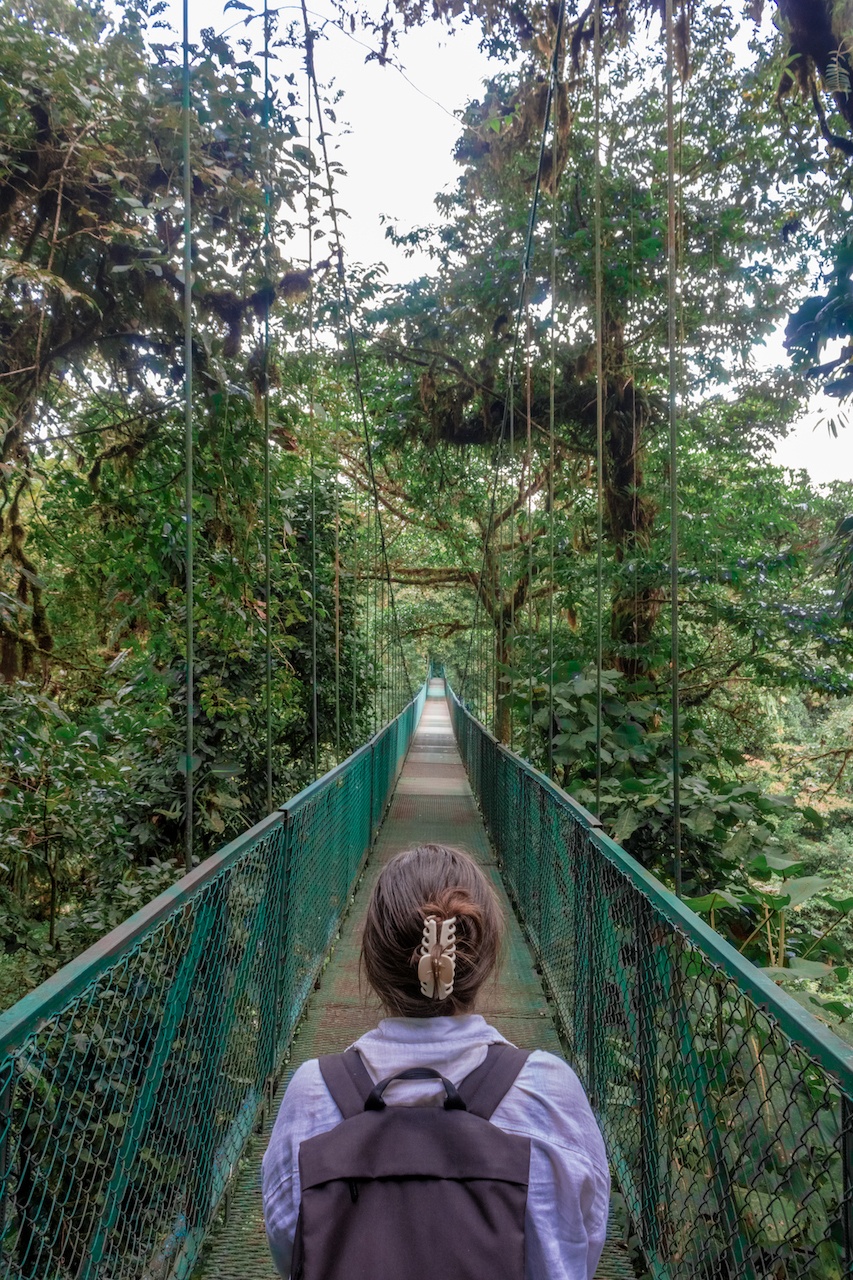Over 4,500 feet above sea level in the interior of Costa Rica lies the Monteverde Cloud Forest. This mystical destination is a far cry from the lavish beach resorts and surf towns on the country’s coast and offers a glimpse Costa Rica’s fantastic biodiversity.
You might be wondering what a cloud forest is. Essentially, it’s like a rain forest, but at a high elevation (between 3,000 and 8,000 feet). The resulting climate is wet, with fog and low-hanging clouds even in the dry season.
The Monteverde Cloud Forest is an immensely rich region with high levels of biodiversity. Even in the dry season, it remains vibrantly green, with enough humidity to keep the plants hydrated and happy.
If you aren’t convinced yet, here are my top reasons why the Monteverde Cloud Forest deserves a spot on your Costa Rica itinerary:
Reasons to Visit Monteverde Cloud Forest, Costa Rica
1. It has one of the longest hanging bridges in Costa Rica.
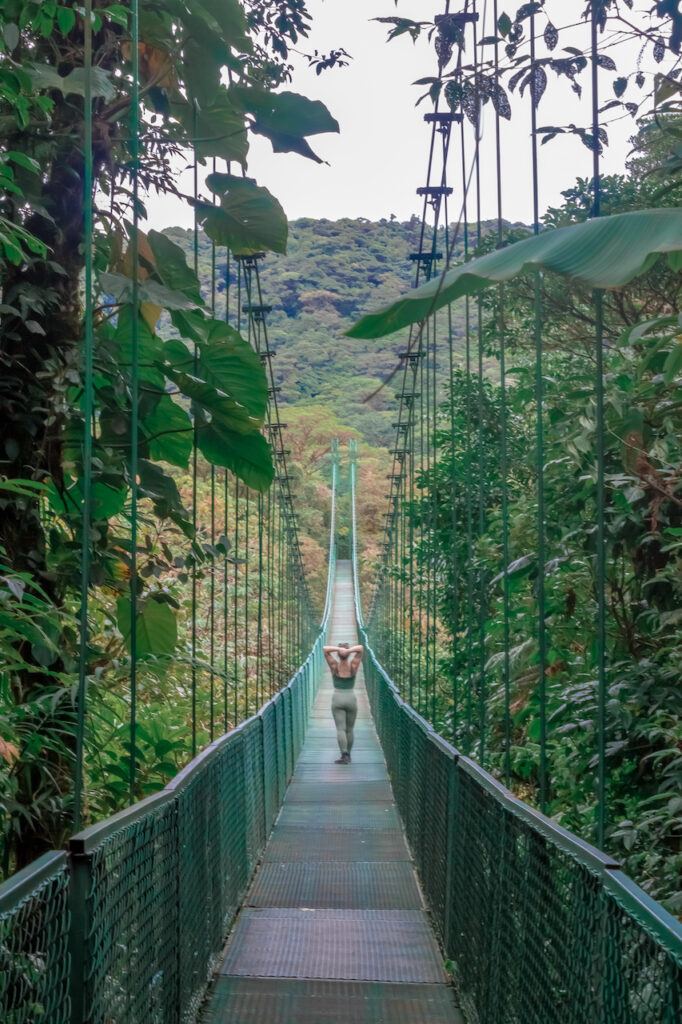
One of the longest hanging bridges in Costa Rica is located in Monteverde, in the Selvatura Adventure Park. The park has eight bridges in total, ranging from 170 to 560 feet long. The 560-foot bridge is a spectacular sight to see, not only for its incredible length but also for the stellar view of the cloud forest canopy below.
To visit the hanging bridges in the Selvatura Adventure Park, you have a couple of options. The first is to only visit the suspension bridges, which costs $42 plus taxes and fees; you can purchase tickets here. The other, which is more cost effective, is to book an all-day pack for $169 plus fees. The cost is steep, but it includes a canopy zip-lining tour and access to the sloth sanctuary (more on that below), the butterfly garden, and the reptile and amphibian exhibition. All of these activities individually would exceed $200, so $169 isn’t so bad.
2. And there are plenty of other hanging bridges to choose from.
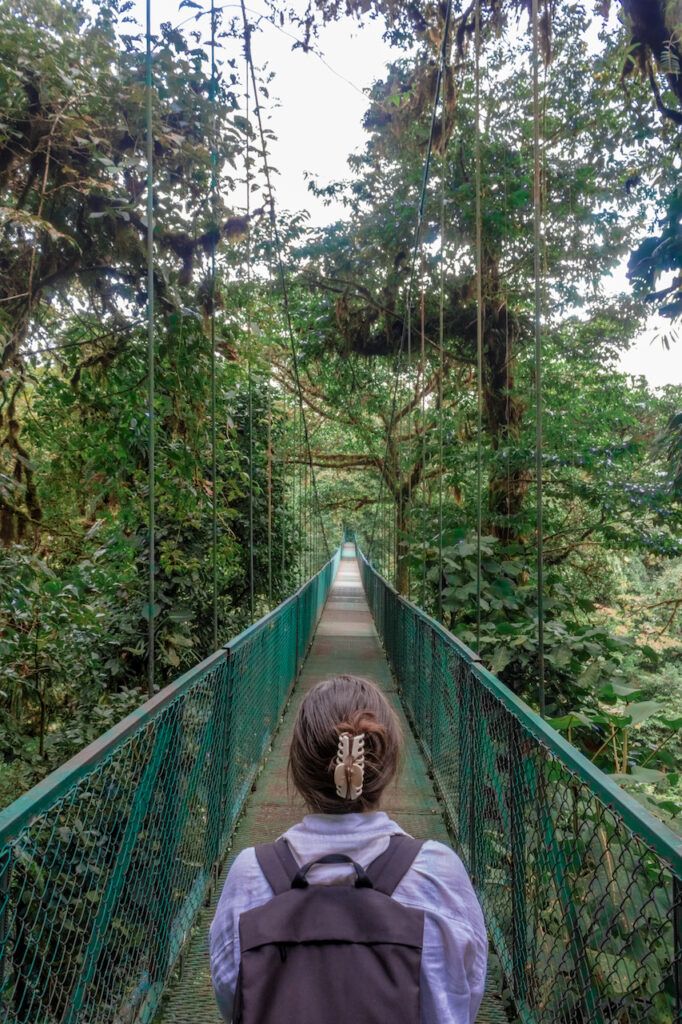
Besides the hanging bridges at Selvatura Adventure Park, there are several other places in Monteverde where you can find them. The Sky Walk at Sky Adventures has many bridges to choose from, with a similar fee scale as Selvatura; packages are available that include several activities, such as zip-lining and a ropes course. (Since I only had time for one of these, I chose Selvatura because of the sloth sanctuary there.)
Another place to find hanging bridges is the Monteverde Cloud Forest Reserve, the town’s main attraction. The bridges here aren’t as impressive in length, but the reserve is definitely worth visiting because of the abundant wildlife. The entrance fee is also much cheaper: $25 plus fees. You can purchase tickets ahead of time here, or buy them at the entrance when you arrive.
3. You can see sloths at the Selvatura Sloth Sanctuary or in the wild.
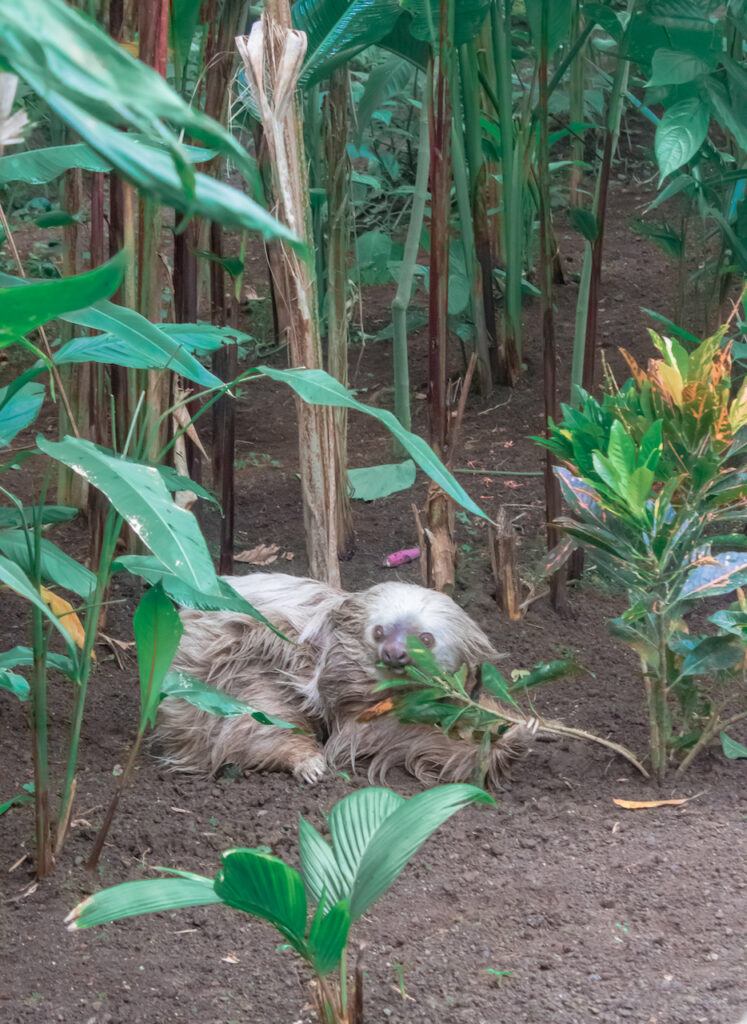
After having a blast spotting sloths in the wild in Manuel Antonio (3.5 hours to the south), I was excited to see them up close. The Sloth Sanctuary at Selvatura Adventure Park is a small enclosure where orphaned and rescued sloths can live out their days safely.
You can only visit the sanctuary with a guide, which made a lot of sense to me when I saw how unafraid of people the animals were. It was also awesome to have an expert explain the sloths’ behavior, diet, and individual stories. I learned, for example, that they only descend to the ground once a week to do their business before climbing back up into the trees.
If you get as excited as I do about sloths, this is a must-visit. Compared to other places I researched beforehand, Selvatura seems like the most careful and ethical of them all. They don’t allow visitors to touch the animals and are mindful about the number of people allowed into the sanctuary at any given time, so as to respect the space. The cost to visit is a bit steep, at $35 plus fees, but bundling into a package that includes several of Selvatura’s activities is a great way to take advantage of everything the park has to offer while saving money on the individual activities.
4. You’ll see plants and animals you probably have never seen before.
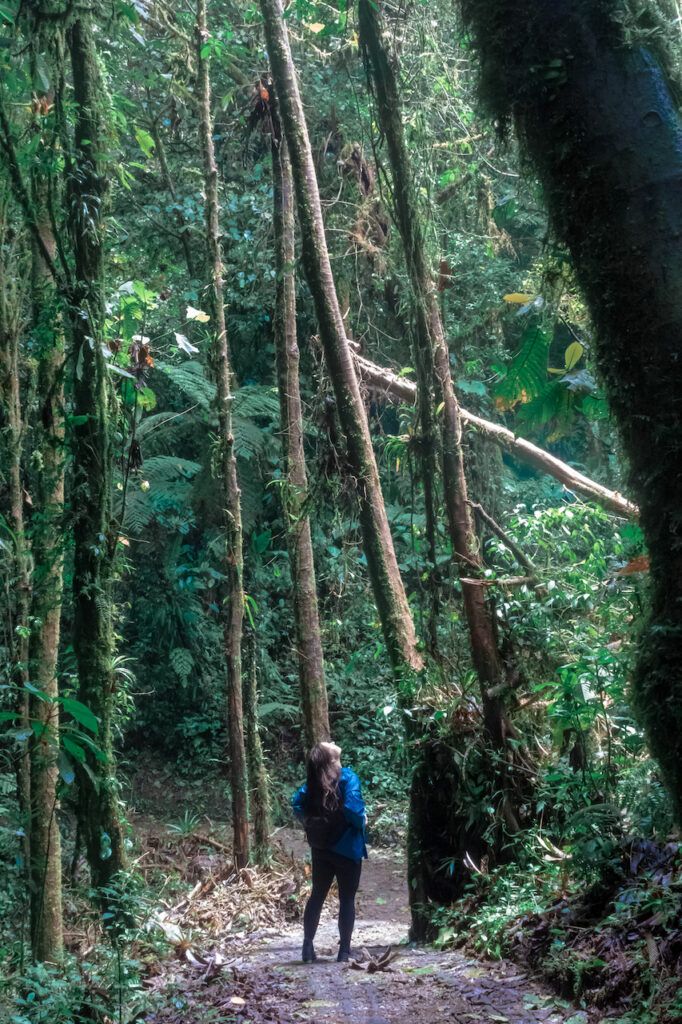
When I tell you that I was amazed by the plants in Monteverde, I mean really, jaw-wide-open amazed. From alien-looking orchids to twisting ficus roots and carnivorous plants, wandering through the cloud forest feels like stepping into a carefully crafted botanical garden — except it’s all wild.
If you’re interested in learning more about plant species in the cloud forest, you can visit the Orchid Garden of Monteverde and take a guided tour to get the scoop on the various plants you can find in the wild. Entrance plus the tour costs $14, so it’s a more affordable activity compared to others in Monteverde.
5. Plus, butterflies, and moths galore!
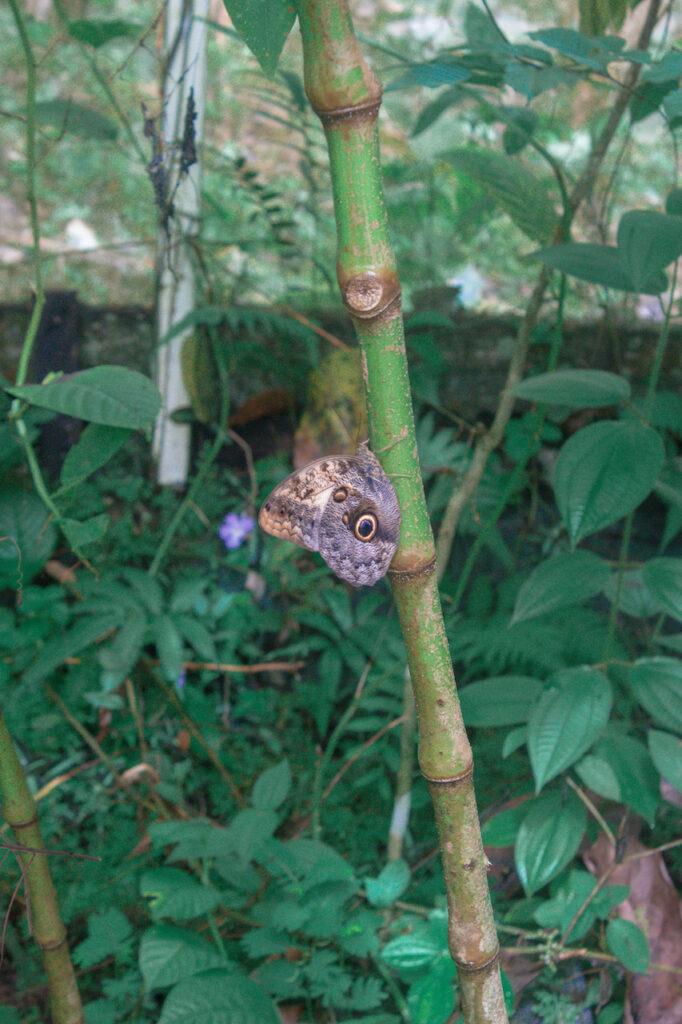
Costa Rica is famous for its biodiversity, which makes it a no-brainer that there are so many colorful butterflies and moths flying around everywhere. Besides keeping an eye out for these magical creatures in the wild, you can also visit Monteverde Butterfly Gardens for an up-close look. Guided tours are available if you want to get in-depth explanations of the plants, butterflies, and other insects in the gardens.
One sweet thing about the gardens is that you can return however often you like during your stay in Monteverde, only paying admission on your first visit. Considering that the entrance fee is $18 plus tax, might as well get your money’s worth, right?
6. There are a variety of hiking trails, long and short.
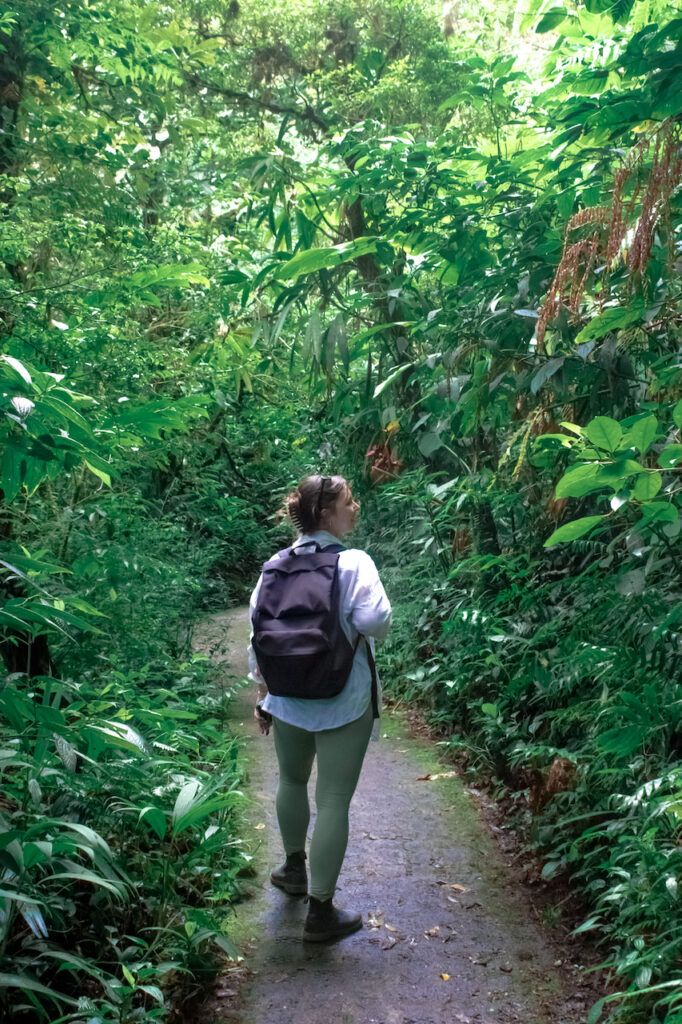
It’s no surprise that hiking is one of the main attractions here, as there are several parks and reserves to choose from. My favorite place to hike and see numerous varieties of plants was the Monteverde Cloud Forest Reserve. The trails there were my favorite, because I got to see both the old forest, with bigger trees and denser brush, and the new, which had leafier foliage and brighter colors.
Other places to hike include the Bosque Eterno de los Niños, which is the largest private reserve in the cloud forest. Here you’ll find a greater density of animals, and longer trails to enjoy. Perhaps the best part is that the admission fee is the among most affordable of the cloud forest reserves: just $15.60 plus tax. There’s also a night tour for just $25 plus tax, which is the cheapest I found in Monteverde — or anywhere in Costa Rica for that matter.
There’s also the Santa Elena Reserve, which has a few trails, an orchid garden, and even a quetzal sanctuary. It costs $16 plus tax to visit, with guided tours available for an additional cost.
7. You can straddle the continental divide between the Caribbean and the Pacific.
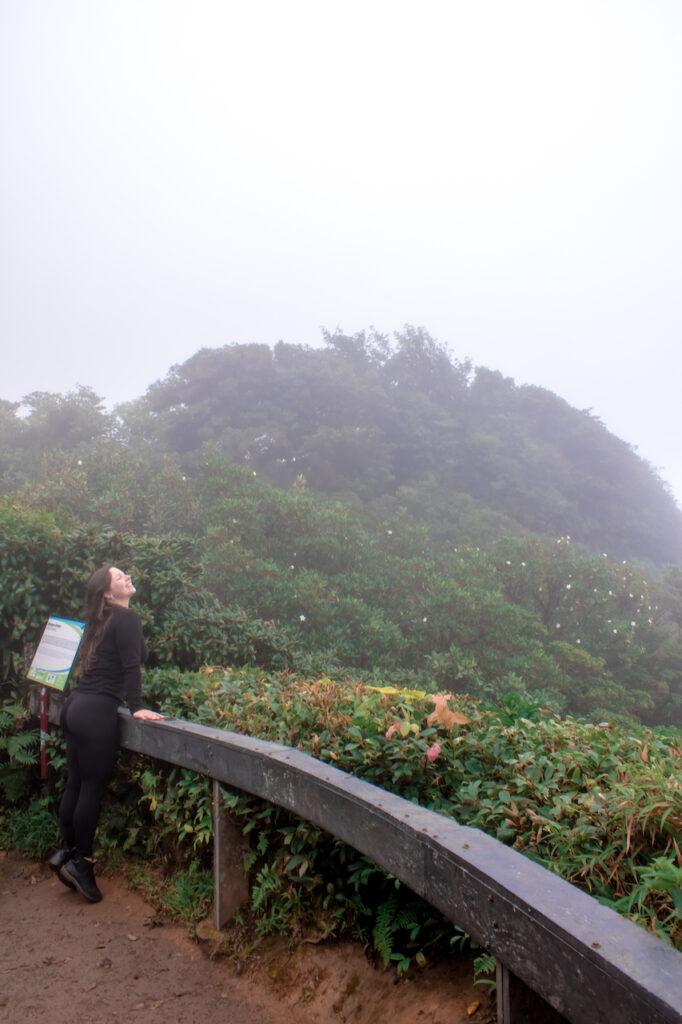
This was one of the most mind-blowing things about Monteverde for me. Within the Monteverde Cloud Forest Reserve is a viewpoint on the continental divide, where you can walk from the Pacific side to the Caribbean side and physically feel the change in the air as it gets denser, slightly warmer, and more humid.
Because of the elevation and climate, don’t expect to get an amazing view from up here. Occasionally the clouds part, and word on the street is you can see all the way to the ocean. However, the day I visited, it was completely covered in fog, which nonetheless lent the place a magical quality.
8. The chilly weather is a welcome break from the heat.
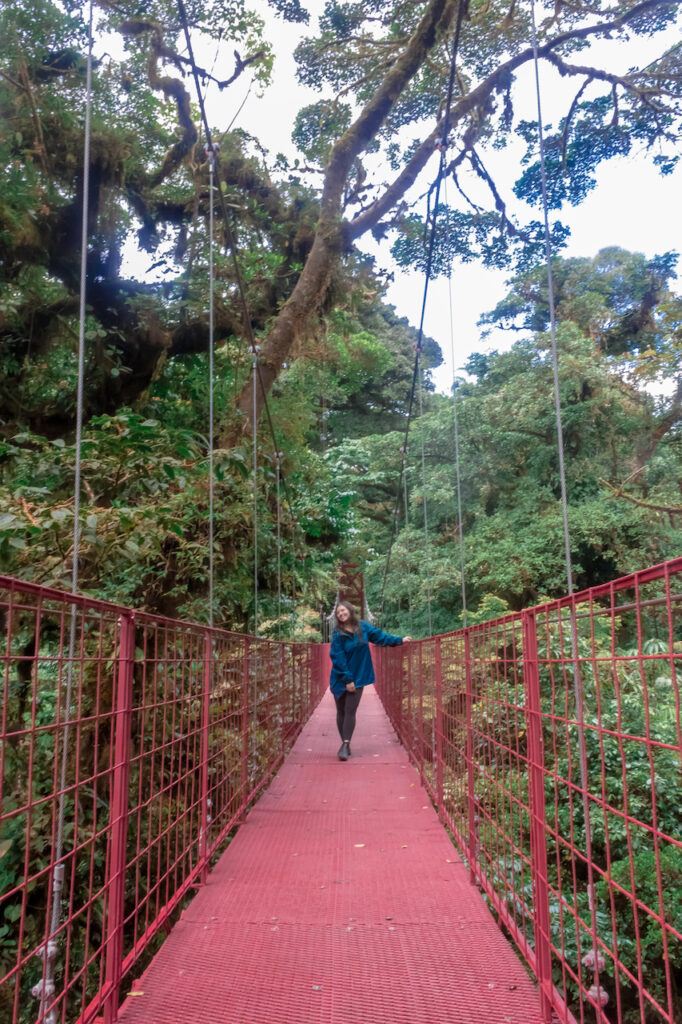
The temperate climate in Monteverde is reminiscent of the Pacific Northwest in the United States during the spring months. It’s humid and cool, with occasional bursts of sunshine and scattered rainstorms throughout the day. If you don’t mind rain and are prepared for it, the showers are no big deal.
Temperatures in Monteverde hover around the mid 60s, dipping into the 50s at night. This is the case for most of the year, with slightly higher temperatures in the dry season (December to March). Whenever you choose to visit, make sure to bring layers and plenty of rain protection.
9. There’s a natural ficus tree bridge that looks unreal.
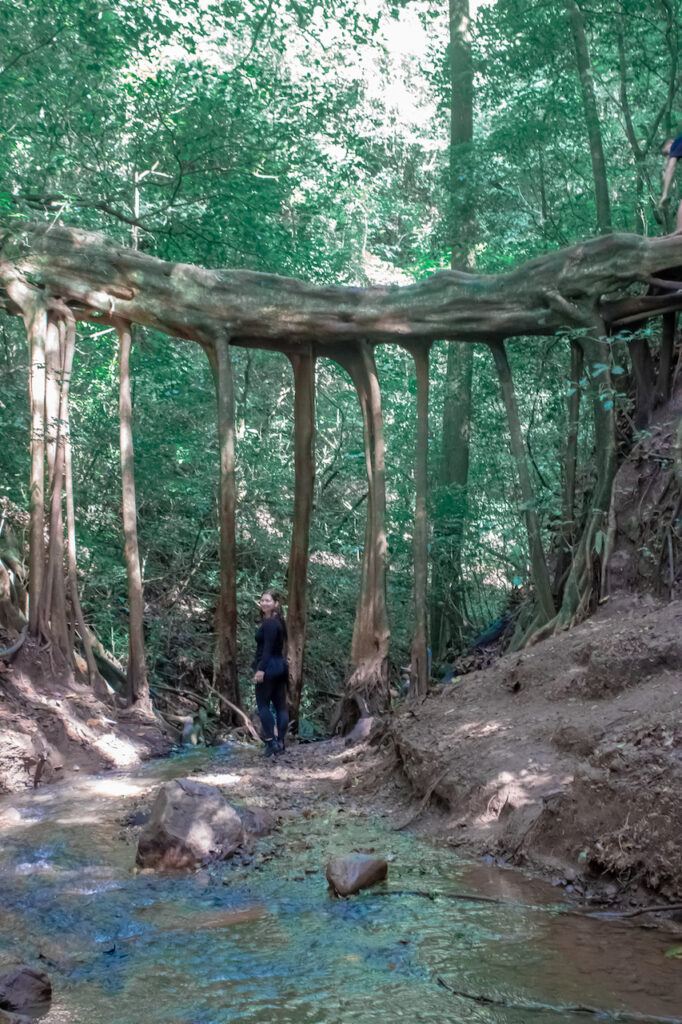
When I say “tree bridge,” you might image a fallen tree over a divide that you can walk across. However, this ficus tree bridge is a far more impressive work of nature.
Throughout the cloud forest, you can find ficus trees in all sorts of formations, some of them even hollow and large enough to climb inside. This one, though, grew in such a way that you can actually walk across it, over the creek below.
There are two ways to access the ficus bridge. One requires that you pay a fee and the hike is much shorter, and one is free with a little longer of a hike. I went for the free route (see the map below for the exact location) — which is the opposite direction from the sign on the side of the main road that reads “ficus tree bridge.” You’ll see the unmarked trail through the forest, which is only about a five-minute hike. Be careful when hiking down, as the trial gets muddy, especially during the rainy season.
If you do decide to climb up to cross the bridge, avoid doing so when it’s raining, as it gets very slippery. I decided not to climb on the bridge itself, because locals warned that it could damage the tree. (The same is true for some of the famous hollow ficus trees in Monteverde, which have suffered the consequences of too many tourists climbing inside.) I was happy just looking at it because, I mean, how cool is that?
10. There are surprises and new things to marvel at around every corner.
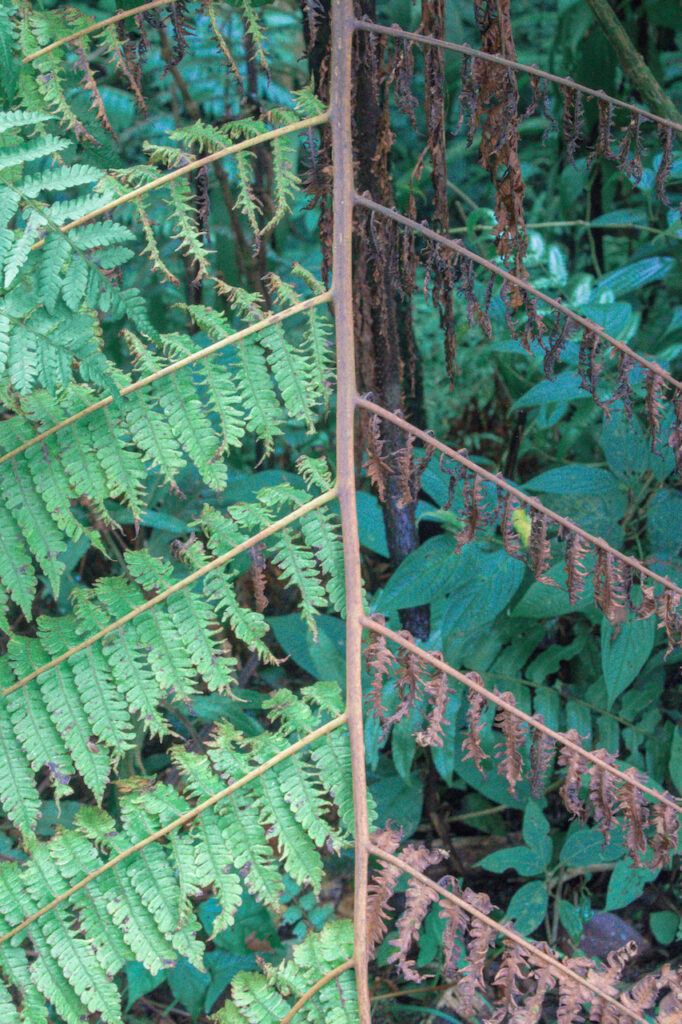
One thing I observed while wandering through the trails, crossing the hanging bridges, and visiting the gardens in Monteverde was how impressive nature can be. There’s this perfect continuous cycle of life and death, renewal and decay.
The point is that I had never been to any destination that was so thoughtful and intentional about conservation and appreciating the natural world before coming to Monteverde. The sheer number of biological reserves and conservation projects completely wowed me. It made me think a lot about the vision of ecotourism using this model and how it could work in other places, where the main goal is to show more people how stunning and magical our planet is.
11. It’s a great place for backpackers.
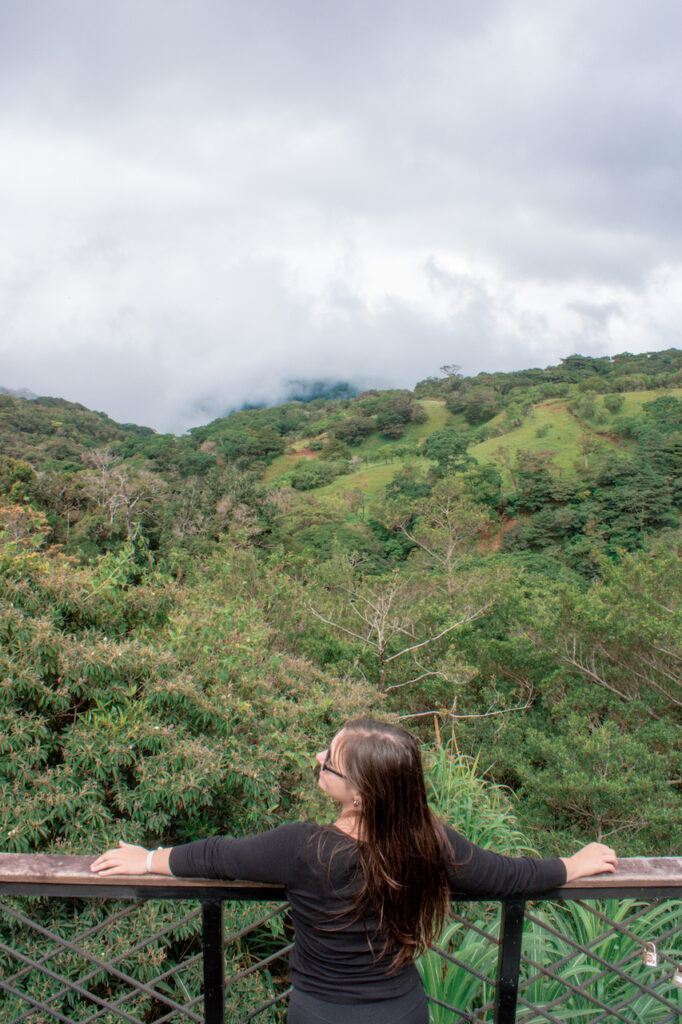
I relied on public transportation and the occasional shuttle service to get around Costa Rica, which wasn’t always easy. However, I found that Monteverde was one of the best places to visit in this regard, because of the simplicity of getting from place to place.
There is a bus that goes back and forth between the downtown area, known as Santa Elena, where most of the restaurants are, and the Monteverde Cloud Forest Reserve. There’s only one main road in Monteverde, and everything in the downtown area is within walking distance. If you stay somewhere outside of downtown, just make sure it’s close to the main road, and you’re good to go.
Taxis are also affordable and easy to grab in Monteverde. They sit in the same spot downtown, and if you want one to pick you up at your accommodations, you can ask for one to be called for you. Also, most big parks, like Selvatura, for example, have their own shuttle service as well, which is included in your ticket price. They’ll come pick you up at your accommodations, and drop you off afterward.
12. It’s a truly mystical place, unlike anywhere else.
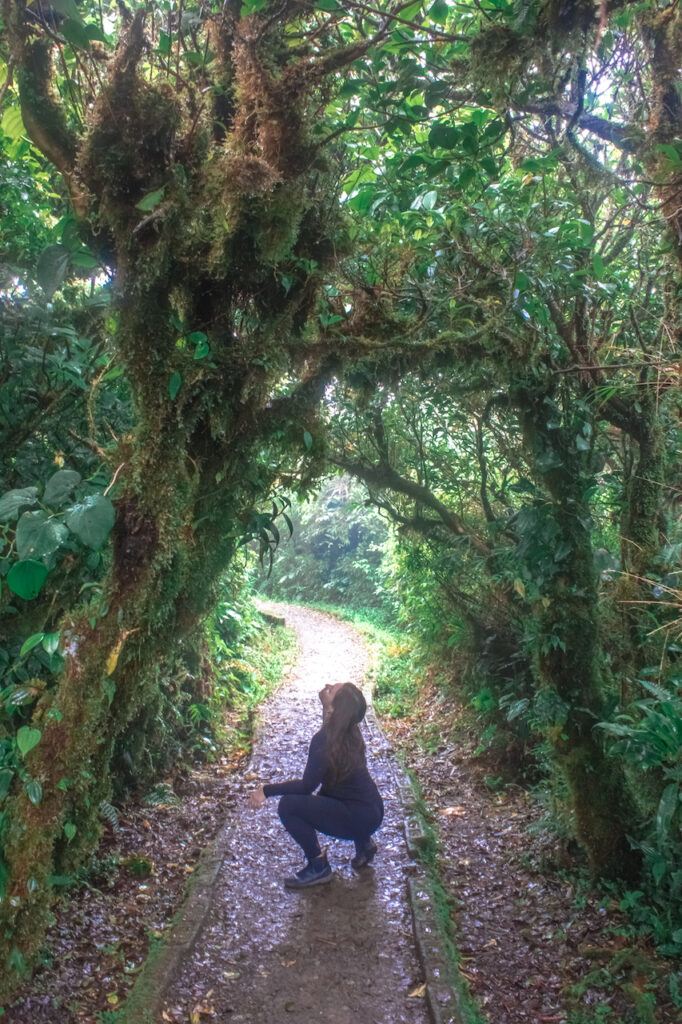
Hands down, Monteverde was my favorite destination in Costa Rica (with Tortuguero a very close second). I had read beforehand that this was a magical place, but I couldn’t have imagined how mystical it would be. The way you can see the clouds rolling in over the mountaintops, the slight chill in the air, the moss hanging from nearly every tree: all of it felt a bit like a fairytale.
Many people compare Monteverde’s downtown area to the mountain towns you’d find in Switzerland or Germany, with log cabins and pine trees everywhere. I have to agree that it feels quite different than others in Costa Rica, but it definitely maintained the same hospitality. Overall, it definitely deserves to be on anybody’s itinerary.
Where to Stay in Monteverde
There are plenty of big hotels to choose from, but I went with a small one near the Monteverde Cloud Forest Reserve called El Bosque. It was one of the most affordable options, but it also exceeded my expectations on quality.
El Bosque has a collection of duplex cabins that form a semicircle around a small meadow in the woods, with other, bigger cabins speckled around the property. Rooms start at $40/night plus fees on Airbnb. I would definitely stay here again.
How to Get to Monteverde
If you are relying on public transportation to get to Monteverde, it can be tricky. Even from San José, there are only two public buses a day: at 6:30am and 2:30pm.
I was traveling from Manuel Antonio, which was even trickier. First, I took a 5:30am bus from Quepos to Puntarenas in order to catch the 8:30am bus from there to Monteverde. Had I missed this bus (which I almost did!), I would have had to wait until 1:30pm to catch the next one.
That said, there are shuttle services from most touristy areas; they range from $60 to $100, depending on how far you are from Monteverde. These are definitely pricey, but they take the pressure off of trying to get the timing right on the public bus.
Map of My Favorite Places in Monteverde
Pin me for later:


Did I mention that Monteverde was my favorite place in Costa Rica? Oops, maybe a few times too many. But seriously, this cloud forest definitely deserves the hype it gets.
If you’re heading to the Monteverde cloud forest, what are you most excited to do there?


